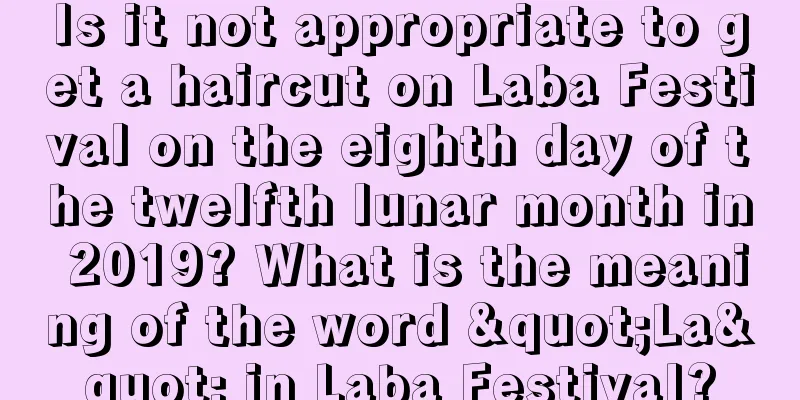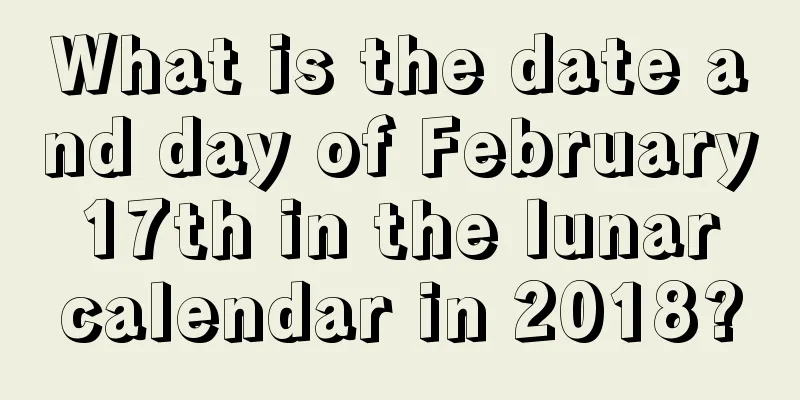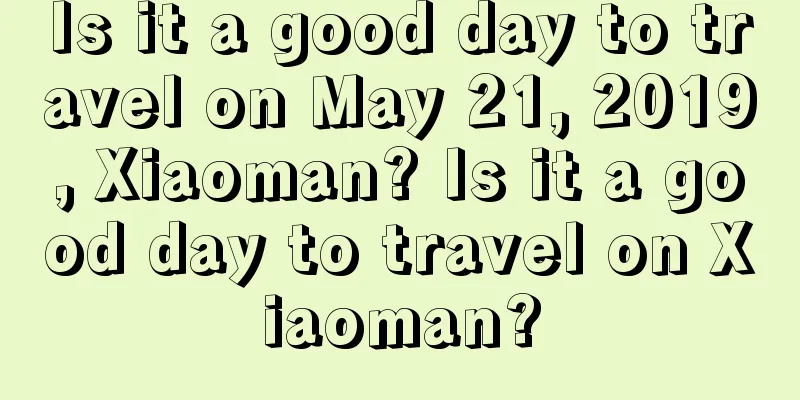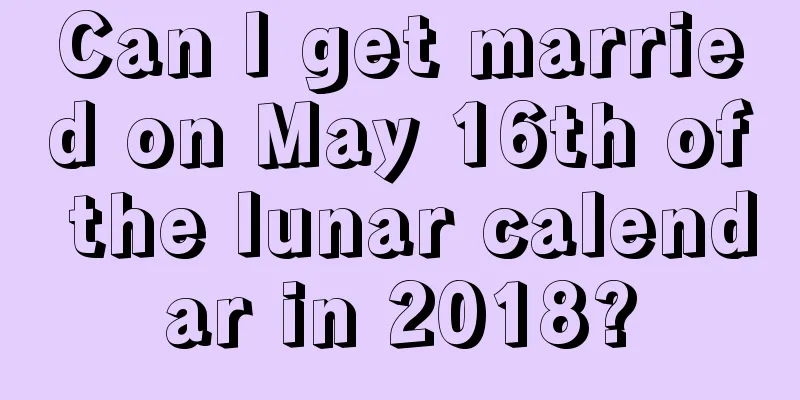Why is there Xiaoman but no Daman among the 24 solar terms? What does Xiaoman represent?
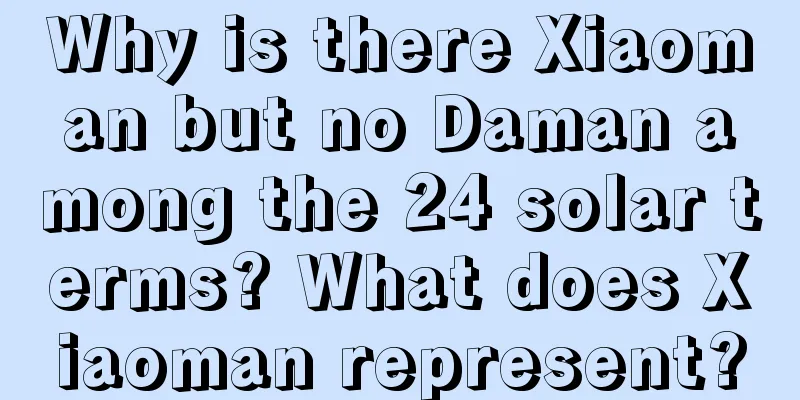
Introduction: Xiaoman is one of the 24 solar terms, and it is also an important solar term. So why is there Xiaoman but not Daman among the 24 solar terms? What does Xiaoman represent? Shuimoxiansheng.com has carefully compiled detailed information about the fourth month of the lunar calendar in 2019. If you want to know about the auspiciousness and inauspiciousness of the fourth month of the lunar calendar, please visit Shuimoxiansheng.com’s special topic on the fourth month of the lunar calendar in 2019!Why is there Xiaoman but no Daman among the 24 solar terms?Daman is not the perfect state pursued by the ancients.When the moon is full it wanes, when the water is full it overflows, and everything will inevitably go downhill after reaching its peak. And "small but full" means that the fruit is half-ripe and still has room to grow, and can "continue to grow taller", which is in line with the Chinese ideal. "The wheat ears are just beginning to grow and the young seeds are tender, the mulberry leaves are growing thick and the silkworms are full." Ancient books say, "In the middle of April, the grains of summer crops such as wheat have begun to become full but are not yet mature, which is approximately equivalent to the late milky stage, so it is called Grain Full." After Grain Full, midsummer is coming. What does Xiaoman represent?Xiaoman - its meaning is that the grains of summer crops begin to fill with juice but are not yet mature. It is only Xiaoman, not Daman.Grain Fullness falls on May 21st of the Gregorian calendar every year. In ancient my country, Grain Full was divided into three stages: "The first stage is the blooming of bitter herbs; the second stage is the death of weeds; the third stage is the arrival of autumn wheat harvest." This means that during the Grain Full solar term, bitter herbs have grown lush branches and leaves; while some shade-loving grasses with thin branches begin to wither and die under the strong sunlight; and the wheat begins to mature at this time. Grain Full is one of the 24 solar terms. Grain Full Moon occurs on May 21 or 22 every year when the sun reaches 60° along the ecliptic. "Collected Explanations of the 72 Seasonal Changes" says: "In the middle of April, there is the Grain Fullness, when things are small but full." At this time, the grains of summer crops such as wheat in northern China have begun to become full but are not yet mature, which is roughly equivalent to the late milky stage, so it is called the Grain Fullness. At this time, it is advisable to speed up the prevention and control of insect pests in wheat fields and prevent attacks from dry and hot winds and sudden thunderstorms and strong winds. Agricultural proverbs related to the Grain Full solar term:wheatGrain Full, Grain Full, the wheat grains are gradually filling up. It is not yet Grain Full, there is still danger. Xiaoman, Xiaoman, still another half month and twenty days. The Grain in Ear season is approaching, and the sickle will begin to grow. Grain in Ear cannot be delayed. When the wheat reaches Grain Full, it turns yellow day and night. Three days after Grain Full, the wheat turns yellow. The ground turns yellow during the ten days of Grain Full. Harvest wheat in cold weather and store it in warehouse when it is hot. The grains are full and the ears are square. Wheat does not like wind, and wind will reduce the harvest. Eighteen days after Grain Full, if the food is not ripe, it will dry up. Eighteen days after Grain Full, the green wheat has grown into flour. He died by the sword ten days after Xiaoman. White flour will appear ten days after Grain Full. The harvest cannot be harvested during Xiaoman, and cannot be harvested in time for Mangzhong. Barley comes on the stage, wheat turns yellow, and peas are crying on the ground. Barley does not mature past Grain in Ear, and wheat does not mature past Grain in Ear. Rice The wheat gradually turns yellow during Grain Full season, and the rice flowers smell fragrant during Summer Solstice. When wheat turns yellow, plant rice (medium rice); when rice turns yellow, plant wheat. Wheat reaches Grain Full, and rice (early rice) reaches Beginning of Autumn. Other crops Grain in Ear, corn and millet. The sesame and grain in grain are fragrant. Grain in Ear, millet and hemp. During Grain Full, sesame and grain are planted, and after the Beginning of Summer, millet is planted. It is a good time to plant sesame, Mangzhong, and beans during Grain Fullness, and wheat during Autumnal Equin If garlic is not harvested during Grain Rain, it will rot in the ground. Plant flowers for peppers and plant buds for eggplants. Your fortune will change over the years, but if you predict and understand it in advance, you can nip it in the bud and make full preparations, making your life journey smoother! To calculate your fortune for the next ten years, please click on the [Quality Calculation] below . We will reveal your exclusive fortune to you and wish you good luck and safety! |
<<: Is April 17, 2019 a suitable date to pick up the car?
Recommend
Is the fate of a baby boy born on May 1, 2022 good? Destiny Analysis
The fate of a baby boy is related to the time when...
Is it a good time to sign a contract on the fourth day of the second lunar month in 2019? How is your fortune on this day?
There are various forms of contract signing, but w...
Is it a good idea to get married or engaged on April 12, 2019 in the lunar calendar?
The fourth month of the lunar calendar has alread...
Is thunder around the Xiaoxue solar term a bad sign or a good sign? Is this a cold winter?
Is thunder around the Xiaoxue solar term a bad sig...
Is September 20th of the lunar calendar 2017 a good day? Is it OK to burn incense and pray?
Introduction: In our country, not only do you need...
Is January 25th of the lunar calendar in 2020 an auspicious day? Is the decoration good?
When people move into a new house, it needs to be ...
Can Xiaohan get a marriage certificate? What should I pay attention to when getting the certificate?
Introduction: Minor Cold is one of the traditional...
Is the second day of the seventh lunar month in 2022 an auspicious day? Is it suitable for traveling?
The seventh month of the lunar calendar arrives wi...
Do people born on National Day in the Year of the Ox have a good fate? Is their life good or bad?
A person's destiny is closely related to his o...
When is the big snow in 2017? What are the food customs during the big snow season?
Introduction: Our country has a splendid food cult...
How are those who died on May Day 2021? Are there any signs before death?
Many of us are afraid of facing death. When death ...
Is it appropriate to hold a funeral on February 29th of the lunar calendar in the Gengzi Year of 2020?
Is it appropriate to hold a funeral on February 29...
Is the day after the summer solstice on May 2, 2020 an auspicious day for sacrifice? Sunset time of the summer solstice in 2020
Introduction: Generally, it is necessary to choose...
Is it auspicious to install a bed when moving on June 11, 2020? Analysis of the Feng Shui of installing a bed
Introduction: It is also necessary to choose an au...
Auspicious dates for weddings in the second half of 2021
2021 is the Year of the Ox. Generally speaking, it...
